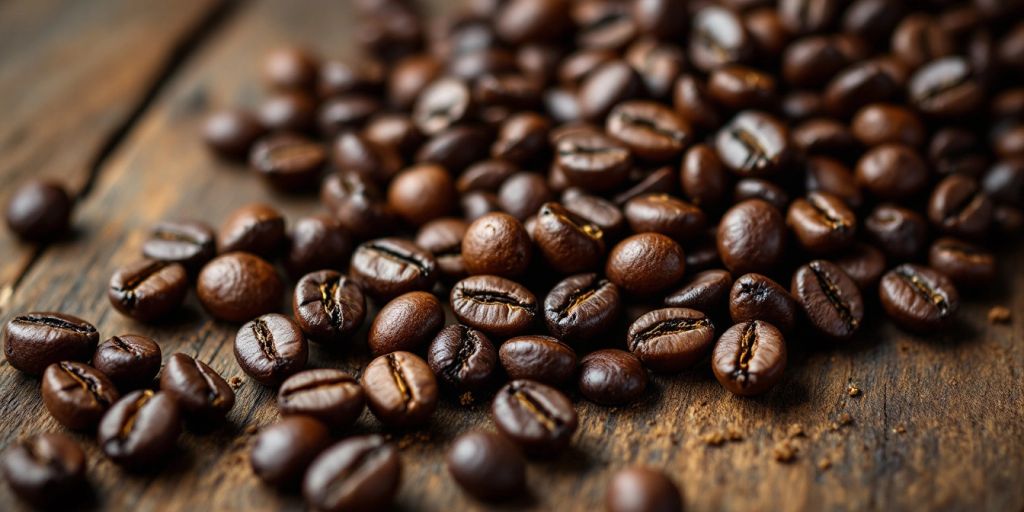Welcome to the delightful world of Arabica coffee beans! If you’re a coffee lover or just starting your journey into the aromatic universe of coffee, this guide is for you. Arabica beans are celebrated for their rich flavors and unique characteristics, making them a favorite among coffee enthusiasts around the globe. In this article, we will explore the captivating flavors, health benefits, history, and the best ways to enjoy Arabica coffee. Get ready to dive into this fascinating topic!
Key Takeaways
- Arabica coffee beans are known for their rich and complex flavors, including fruity, floral, nutty, and chocolatey notes.
- These beans have a lower caffeine content, making them a great choice for those who want a milder coffee experience.
- The history of Arabica coffee traces back to Ethiopia, where it was first discovered and later spread to other regions.
- Arabica coffee thrives in high-altitude areas with specific growing conditions, which enhances its quality and taste.
- There are various popular Arabica coffee varieties, each with its unique flavor profile, making it a favorite among coffee drinkers.
The Unique Flavor Profiles of Arabica Coffee Beans
Arabica coffee beans are celebrated for their rich and diverse flavors that captivate coffee lovers around the globe. These beans offer a delightful journey through various taste sensations, making each cup a unique experience.
Fruity and Floral Notes
Arabica coffee often showcases a range of fruity and floral notes. Here are some common flavors:
- Berries: Many Arabica coffees have hints of berries, adding a sweet and tangy twist.
- Citrus: A bright, zesty flavor that can elevate the overall taste.
- Floral: Some varieties, especially from Ethiopia, can have delicate floral aromas reminiscent of jasmine or chamomile.
Nutty and Chocolatey Undertones
In addition to fruity flavors, Arabica beans can also present:
- Nutty: A smooth, nutty flavor that adds depth and richness.
- Chocolatey: Many Latin American Arabicas have a subtle chocolate undertone, making them comforting and familiar.
- Caramel: A sweet, buttery finish that rounds out the flavor profile.
Influence of Growing Conditions
The flavor of Arabica coffee is heavily influenced by its growing conditions. Factors such as altitude, soil type, and climate play a crucial role:
- High Altitude: Beans grown at higher elevations often have a more complex flavor due to slower maturation.
- Soil Quality: Rich volcanic soils can enhance the bean’s flavor, contributing to its unique characteristics.
- Climate: Variations in temperature and rainfall can lead to different flavor profiles, making each region’s coffee distinct.
"The journey of Arabica coffee from bean to cup is a testament to nature’s artistry, creating flavors that tell a story."
In summary, the unique flavor profiles of Arabica coffee beans are a blend of fruity, floral, nutty, and chocolatey notes, all shaped by their growing conditions. This complexity is what makes Arabica a favorite among coffee enthusiasts, inviting them to explore its rich tapestry of flavors.
Health Benefits of Arabica Coffee Beans
Lower Caffeine Content
Arabica coffee beans are known for their lower caffeine levels, making them a great choice for those who want to enjoy coffee without the jitters. This means you can sip your favorite brew without worrying about feeling too wired!
Rich in Antioxidants
These beans are packed with antioxidants, which help fight free radicals in the body. This can lead to better overall health and may even reduce the risk of certain diseases. Here are some key benefits:
- Supports heart health
- Boosts brain function
- May lower the risk of certain cancers
Potential Health Advantages
Drinking Arabica coffee can offer several health perks:
- Improved mood: The aroma and taste can enhance your mood and make your day brighter.
- Enhanced metabolism: It may help in burning fat and boosting metabolism.
- Reduced risk of diabetes: Some studies suggest that regular coffee drinkers may have a lower risk of developing type 2 diabetes.
Enjoying a cup of Arabica coffee not only delights your taste buds but also brings a host of health benefits that can enhance your lifestyle.
In summary, Arabica coffee is not just about flavor; it’s also about health and well-being. So, indulge in that cup of coffee and savor the benefits!
The History and Journey of Arabica Coffee Beans

Origins in Ethiopia
The story of Arabica coffee begins in the lush landscapes of Ethiopia, where it is believed that a shepherd named Kaldi discovered its energizing effects around 800 AD. This discovery sparked a global love for coffee!
Spread to Yemen and Beyond
From Ethiopia, Arabica coffee made its way to Yemen, where it became a vital part of culture and trade. The port of Moka became a bustling hub for coffee trade, allowing the beverage to spread to Egypt and Turkey. Coffee houses, known as qahveh khaneh, emerged, becoming social centers for people to gather and enjoy this delightful drink.
Cultural Significance
In Yemen, coffee was initially linked to religious practices, helping people stay awake during long ceremonies. As its popularity grew, it transitioned into everyday life, influencing social interactions and cultural traditions across the Middle East.
The journey of Arabica coffee is not just about the drink; it’s about the connections and communities it has built over centuries.
Key Takeaways
- Historical Roots: Arabica coffee’s journey began in Ethiopia, around 800 AD.
- Global Journey: It spread from Yemen to various parts of the world, thanks to trade routes.
- Cultural Impact: Coffee houses became essential social hubs, shaping cultural life.
Conclusion
So, the next time you sip on a cup of Arabica, remember its rich history and the art of coffee tasting that has evolved through the ages!
Growing and Harvesting Arabica Coffee Beans

Ideal Climatic Conditions
Arabica coffee thrives in specific climatic conditions. It prefers higher altitudes, where the air is cooler and the soil is rich. Here are some key factors:
- Elevation: Grows best at 2,000 to 6,000 feet.
- Temperature: Ideal range is 60°F to 70°F.
- Rainfall: Requires 40 to 100 inches of rain annually.
High Altitude Cultivation
High altitude is crucial for developing the rich flavors of Arabica beans. The cooler temperatures slow the growth of the coffee cherries, allowing them to develop more complex flavors. This results in a smoother, more aromatic cup of coffee.
Harvesting Techniques
Harvesting Arabica coffee is an art. Here are the main methods:
- Handpicking: Skilled workers select only the ripe cherries, ensuring quality.
- Selective Picking: Multiple passes are made to gather only the best cherries.
- Mechanical Harvesting: Machines strip or shake the trees, but may mix ripe and unripe cherries.
The journey from tree to cup is filled with care and precision, making each sip of Arabica a delightful experience.
In summary, the combination of ideal growing conditions and careful harvesting techniques makes Arabica coffee a favorite among coffee lovers. Experience the rich flavors that come from these meticulous practices!
Popular Arabica Coffee Bean Varieties
When it comes to Arabica coffee, the variety you choose can make a huge difference in flavor. Here are some of the most popular types:
Typica and Bourbon
- Typica: Known for its smooth, balanced flavor with hints of chocolate and caramel.
- Bourbon: Offers a sweeter profile with fruity notes, making it a favorite among coffee lovers.
Regional Variations
- Café de Colombia: This variety is produced using different Arabica types like Caturra and Maragogipe, showcasing a rich flavor profile.
- Ethiopian Coffees: Known for their floral and fruity notes, these beans are often considered some of the best in the world.
Specialty Coffee Varieties
- Geisha: Famous for its unique flavor, often described as tea-like with floral notes.
- F1 Hybrids: These are newer varieties that combine the best traits of traditional beans, offering improved disease resistance and flavor.
Choosing the right variety can elevate your coffee experience. Whether you’re brewing a morning cup or crafting the perfect espresso, understanding these varieties is key to enjoying the rich flavors of Arabica coffee.
In summary, the world of Arabica coffee is diverse and exciting. Each variety brings its own unique taste, making it essential for coffee lovers to explore and discover their favorites!
Brewing the Perfect Cup of Arabica Coffee
Choosing the Right Beans
To brew an amazing cup of Arabica coffee, start with high-quality beans. Look for:
- Freshly roasted beans
- Single origin varieties for unique flavors
- Beans with a roast date within the last few weeks
Grinding and Brewing Methods
The grind size and brewing method can make a big difference. Here’s how to get it right:
- Grind just before brewing to keep flavors fresh.
- Use a medium grind for drip coffee and a fine grind for espresso.
- Experiment with brewing methods like pour-over, French press, or espresso to find your favorite.
Enhancing Flavor Profiles
To elevate your coffee experience, consider these tips:
- Use filtered water for a cleaner taste.
- Adjust the coffee-to-water ratio to suit your preference.
- Try adding a pinch of salt to reduce bitterness.
Brewing Arabica coffee is an art that combines quality beans, the right grind, and personal touch. Master these elements to enjoy a cup that’s truly special.
Remember, the journey to the perfect cup starts with understanding your preferences and experimenting with different techniques. Happy brewing!
Exploring Arabica Coffee Regions
Ethiopian Coffees
Ethiopia is the birthplace of coffee, and its Arabica beans are renowned for their diverse flavors. From the floral notes of Yirgacheffe to the fruity hints of Sidamo, Ethiopian coffees offer a unique tasting experience. The high altitudes and rich soils contribute to their exceptional quality.
Latin American Coffees
Countries like Colombia and Brazil produce some of the best Arabica beans. These coffees are known for their smooth body and balanced flavors, often featuring notes of chocolate and nuts. The ideal growing conditions in these regions help create a clean and sweet cup.
Pacific and Indian Coffees
Indonesian coffees, particularly from Sumatra and Java, are famous for their full body and earthy flavors. Sumatran beans, processed using a unique wet-hulling method, often have spicy and herbal notes. Javanese coffees are smoother and slightly sweet, making them a favorite among many coffee lovers.
| Region | Flavor Profile | Notable Characteristics |
|---|---|---|
| Ethiopia | Floral, fruity | High altitude, rich soils |
| Latin America | Chocolate, nutty | Smooth body, bright acidity |
| Indonesia | Earthy, spicy | Unique processing methods |
Each coffee-producing region imparts its unique stamp on the beans, resulting in a diverse spectrum of flavors and experiences for coffee enthusiasts worldwide.
Understanding these regional differences can enhance your appreciation of coffee and its global cultural significance. Explore the rich flavors of Arabica coffee from around the world!
Dive into the world of Arabica coffee and discover the unique regions where it thrives. Each area offers its own special flavors and stories that make every cup a journey. Want to learn more about these amazing coffee regions? Visit our website for all the details!
Final Thoughts on Arabica Coffee
In conclusion, Arabica coffee beans offer a delightful journey through taste and history. From their beginnings in Ethiopia to their rise as a favorite worldwide, these beans bring a rich flavor that many coffee lovers cherish. With their unique characteristics, like lower caffeine and a variety of flavors, Arabica coffee stands out in the coffee world. Whether you enjoy it for its smoothness or the complex tastes, every cup of Arabica tells a story. So, the next time you sip your coffee, take a moment to appreciate the journey of these special beans.
Frequently Asked Questions
What makes Arabica coffee beans different from Robusta?
Arabica coffee beans are known for their smoother, more complex flavors, while Robusta beans tend to be stronger and more bitter.
Why is Arabica coffee considered healthier?
Arabica coffee has less caffeine than Robusta, making it a better option for those who want to reduce their caffeine intake.
Where do Arabica coffee beans come from?
Arabica coffee beans originated in Ethiopia but are now grown in many countries, including Colombia and Brazil.
How can I brew the best cup of Arabica coffee?
To brew a great cup, use fresh Arabica beans, grind them just before brewing, and choose a method that suits your taste.
What are the flavor notes of Arabica coffee?
Arabica coffee often has fruity, floral, nutty, and chocolatey flavors, making it a favorite among coffee lovers.
Are there different varieties of Arabica coffee?
Yes, there are several varieties of Arabica coffee, including Typica and Bourbon, each with unique taste profiles.



